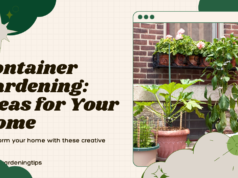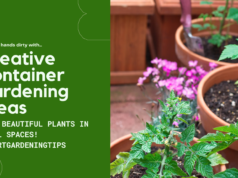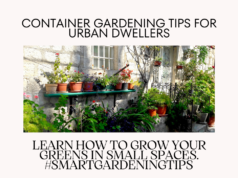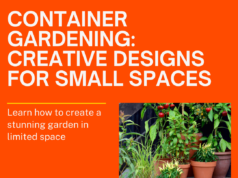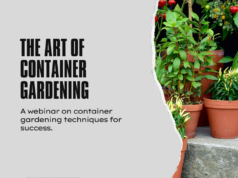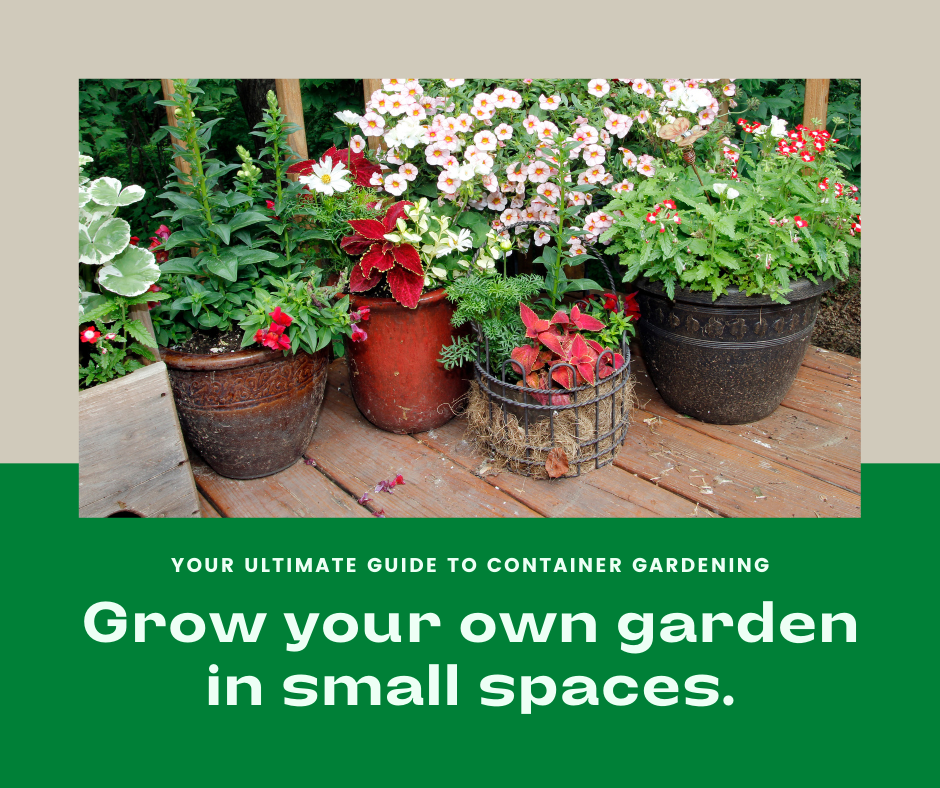
Welcome to The Essential Guide to Container Gardening Principles! Whether you have limited space or simply want an easy and convenient way to grow your own plants, container gardening is a fantastic option. In this guide, we will explore the principles of container gardening that will help you create a thriving and beautiful garden in containers.
Container gardening offers numerous benefits. Not only does it allow you to grow plants in small spaces, such as balconies, patios, or even windowsills, but it also provides flexibility and easy maintenance. With containers, you have control over the soil quality, watering, and sunlight exposure, making it easier to cater to the specific needs of your plants.
In this comprehensive guide, we will cover everything you need to know about container gardening principles. From choosing the right containers and selecting suitable plants to designing your container garden for visual interest and providing essential care tips, we’ll guide you every step of the way.
Key Takeaways:
- Container gardening is a great option for those with limited space or looking for easy maintenance.
- Choosing the right containers is crucial for the success of your container garden.
- Different types of containers suit different plants, so it’s important to match them accordingly.
- Consider factors like growth habit, light requirements, and climate when selecting plants for your containers.
- Designing your container garden with visual interest and harmony enhances its overall appeal.
Choosing the Right Containers for Your Garden
When it comes to container gardening, choosing the right containers is crucial for the success of your plants. Factors such as size, material, drainage, and aesthetics should all be considered when making your selection. Let’s explore these factors in detail to help you make informed choices for your garden.
Size Matters
One of the first factors to consider is the size of the container. The size should be appropriate for the specific plant you intend to grow. Different plants have different root systems and growth habits, so it’s important to provide enough space for them to thrive. A container that is too small can restrict root growth, leading to stunted or unhealthy plants.
Material Selection
The material of the container can impact both the aesthetics and the health of your plants. Common container materials include clay, plastic, and wood. Clay pots are porous and allow better airflow to the roots, but they can dry out quickly. Plastic containers are lightweight and retain moisture well, making them a good choice for water-loving plants. Wood containers provide insulation and are popular for their natural look, but they require proper sealing to prevent rotting.
Adequate Drainage
Proper drainage is essential to prevent waterlogged roots and root rot. Containers should have drainage holes at the bottom to allow excess water to escape. If your chosen container doesn’t have drainage holes, make sure to create them yourself to ensure the health of your plants.
“Choosing a container with good drainage is like providing your plants with a lifeline. It helps maintain the right moisture balance and prevents the dreaded root rot.”
Aesthetics and Style
While functionality is important, don’t forget to consider the aesthetics of your containers. Your garden should be a visual delight, and the containers play a significant role in achieving that. Think about the style and design of your outdoor space to select containers that complement the overall look. You can choose from a wide range of colors, shapes, and textures to add depth and visual interest to your garden.
Types of Containers Suitable for Different Plants
When it comes to container gardening, choosing the right type of container is crucial for the success of your plants. Different plants have different needs, and selecting the appropriate container can provide the optimal growing conditions. Let’s explore the various types of containers available and discuss which ones are best suited for specific plants.
Pots and Planters
Traditional pots and planters are versatile and widely used in container gardening. They come in various sizes, shapes, and materials, including ceramic, clay, plastic, and fiberglass. These containers provide excellent drainage and are ideal for growing small to medium-sized plants such as herbs, flowers, and vegetables. Their portability allows you to move them around to find the best sunlight exposure.
Hanging Baskets
If you have limited space or want to add vertical interest to your garden, hanging baskets are a perfect choice. These containers are suspended from hooks or brackets, allowing you to grow trailing and cascading plants. Hanging baskets are particularly suited for flowers like petunias, fuchsias, and ivy geraniums, which create a beautiful display of vibrant colors and lush foliage.
Window Boxes
Window boxes are a charming option for those who want to enhance the aesthetic appeal of their windows and walls. These long and narrow containers are typically mounted on window sills or attached to railings. Window boxes are perfect for growing herbs, small flowering plants, and succulents. Their close proximity to the house can also provide added protection from extreme weather conditions.
Vertical Gardens
If you’re short on horizontal space but still want to cultivate a wide variety of plants, vertical gardens are a fantastic solution. These systems allow you to grow plants vertically on wall-mounted panels or freestanding structures. Vertical gardens are excellent for growing herbs, salad greens, and flowers, and can create a stunning visual display in both indoor and outdoor spaces.
Self-Watering Containers
For those with busy schedules or who tend to forget to water their plants, self-watering containers are a game-changer. These containers feature built-in reservoirs that hold excess water, allowing the plants to draw moisture as needed. Self-watering containers are particularly suitable for plants that prefer consistent moisture levels, such as tomatoes, peppers, and tropical foliage plants.
Tabletop Containers
If you have limited space or want to bring the beauty of plants indoors, tabletop containers are a great option. These small and portable containers can be placed on tables, countertops, or shelves. Tabletop containers are perfect for growing small herbs, succulents, and dwarf varieties of flowering plants. They add a touch of greenery to your living spaces while fitting seamlessly into any interior design.
“Choosing the right container is essential for successful container gardening. It determines the overall health and growth of your plants.”
Keep in mind that while these containers work well for specific plant types, it’s essential to consider the individual needs of each plant. Factors such as sunlight requirements, soil moisture levels, and root space should be taken into account when selecting a container.
| Container Type | Best Suited Plants |
|---|---|
| Pots and Planters | Herbs, flowers, vegetables |
| Hanging Baskets | Trailing and cascading plants |
| Window Boxes | Herbs, small flowering plants, succulents |
| Vertical Gardens | Herbs, salad greens, flowers |
| Self-Watering Containers | Plants that prefer consistent moisture |
| Tabletop Containers | Small herbs, succulents, dwarf flowering plants |
Selecting the Perfect Plants for Your Containers
When it comes to container gardening, selecting the right plants is crucial to ensure a thriving garden. In this section, we’ll guide you through the process of choosing plants that are suitable for container gardening, taking into account factors like growth habits, light requirements, and climate considerations.
Growth Habits
Choosing plants with appropriate growth habits is essential for container gardening success. Consider the mature size of the plants and make sure they won’t outgrow their containers. Opt for compact varieties or those specifically bred for container gardening. This will prevent overcrowding, allow better air circulation, and promote healthy root development.
Light Requirements
Understanding the light requirements of your chosen plants is essential to ensure they receive adequate sunlight or shade. Different plants have different light preferences, ranging from full sun to partial shade. Assess your garden’s sun exposure and select plants that thrive in those conditions.
Climate Considerations
Take into account your region’s climate and select plants that are well-suited to the conditions. Some plants are more tolerant of extreme temperatures, while others thrive in mild climates. Research the hardiness zones and growing seasons in your area to make informed decisions about the plants that will flourish in your containers.
Pro Tip: Consider using native plants or those adapted to your specific region. These plants are often more resistant to pests and diseases and require less maintenance, making them ideal choices for container gardening.
Now that you understand the importance of selecting the perfect plants for your containers, let’s dive into some examples of plants that are particularly suitable for container gardening:
| Plant | Growth Habit | Light Requirements | Climate Adaptability |
|---|---|---|---|
| Rosemary | Compact, upright | Full sun | Hardy in zones 7-10 |
| Geraniums | Mounding, trailing | Full sun to partial shade | Varies by variety |
| Succulents | Compact, rosette-like | Full sun | Varies by variety |
| Impatiens | Mounding, spreading | Partial shade to full shade | Hardy in zones 10-11 |
These are just a few examples, and the possibilities are endless. Consider your individual preferences, the visual appeal of the plants, and their compatibility with each other when creating unique and stunning container gardens.
Designing Your Container Garden for Visual Interest
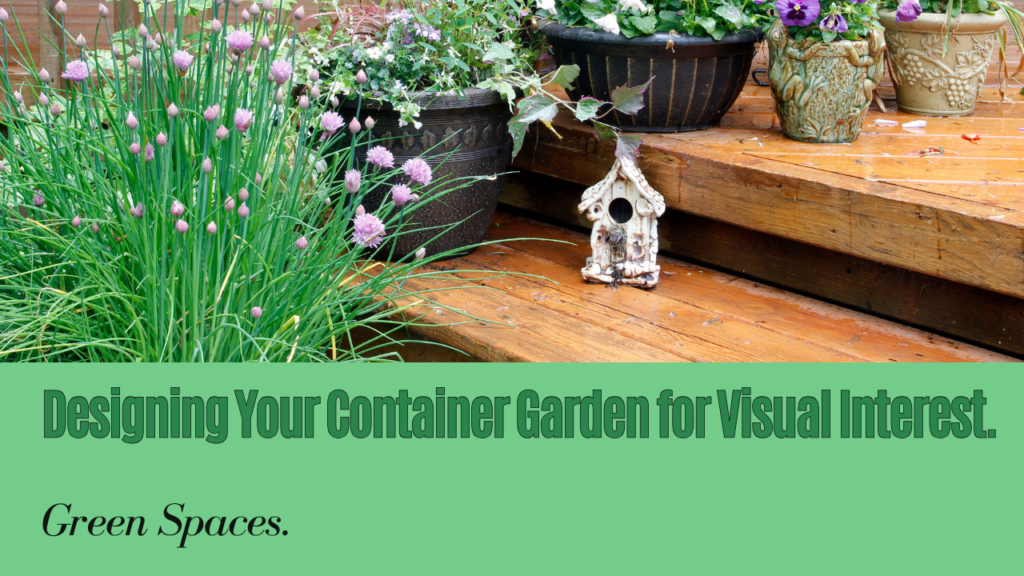
When it comes to container gardening, creating visual interest and harmony is key to transforming your outdoor space into a stunning oasis. By incorporating principles of design, you can elevate your container garden from simply being a collection of potted plants to a visually captivating masterpiece. Let’s explore some essential principles that will help you design a container garden that is both aesthetically pleasing and harmonious.
1. Color Coordination
One of the fundamental principles of designing a container garden is color coordination. Choose plants with complementary or contrasting colors to create a visually striking arrangement. Consider the color wheel and opt for harmonious combinations, such as pairing warm colors like red and orange with cool colors like blue and purple. You can also create a monochromatic color scheme by using different shades of the same color for a more subtle and elegant look.
2. Texture Variation
Another way to add visual interest to your container garden is by incorporating plants with different textures. Mix plants with smooth, glossy leaves with those that have a rough, textured surface. Consider combining plants with fine, delicate foliage alongside ones with bold, architectural leaves. The contrast in textures will add depth and dimension to your container garden, creating a visually pleasing composition.
3. Height Variation
Creating height variation is essential to designing a container garden that is visually appealing. Choose plants with different heights and growth habits to add vertical interest. Place taller plants at the back or center of your container, and cascade shorter plants over the edges. This layering effect not only adds visual appeal but also maximizes the use of space in your container garden.
Remember, the key to successful design in container gardening is finding the right balance between color, texture, and height. Experiment with different combinations and arrangements to create a container garden that reflects your personal style and taste.
To help you visualize these design principles, take a look at this stunning container garden:
| Plant | Color | Texture | Height |
|---|---|---|---|
| Lavender | Purple | Soft, feathery | Medium |
| Caladium | Green, pink | Large, heart-shaped leaves | Medium |
| Creeping Jenny | Yellow-green | Trailing, fine texture | Low |
| Coleus | Red, pink, green | Variegated, serrated leaves | Medium |
In this container garden, the combination of purple lavender, green and pink caladium, yellow-green creeping jenny, and multicolored coleus creates a harmonious blend of colors. The varying textures of the plants, from soft and feathery to large and heart-shaped leaves, add visual interest. Additionally, the height variation, with lavender and caladium in the center and trailing creeping jenny at the edges, creates a balanced and visually appealing composition.
By applying these principles of design, you can elevate your container garden into a work of art. Experiment with different plant combinations, colors, textures, and heights to design a container garden that not only brings joy to your space but also showcases your personal style.
Essential Care Tips for Thriving Container Plants
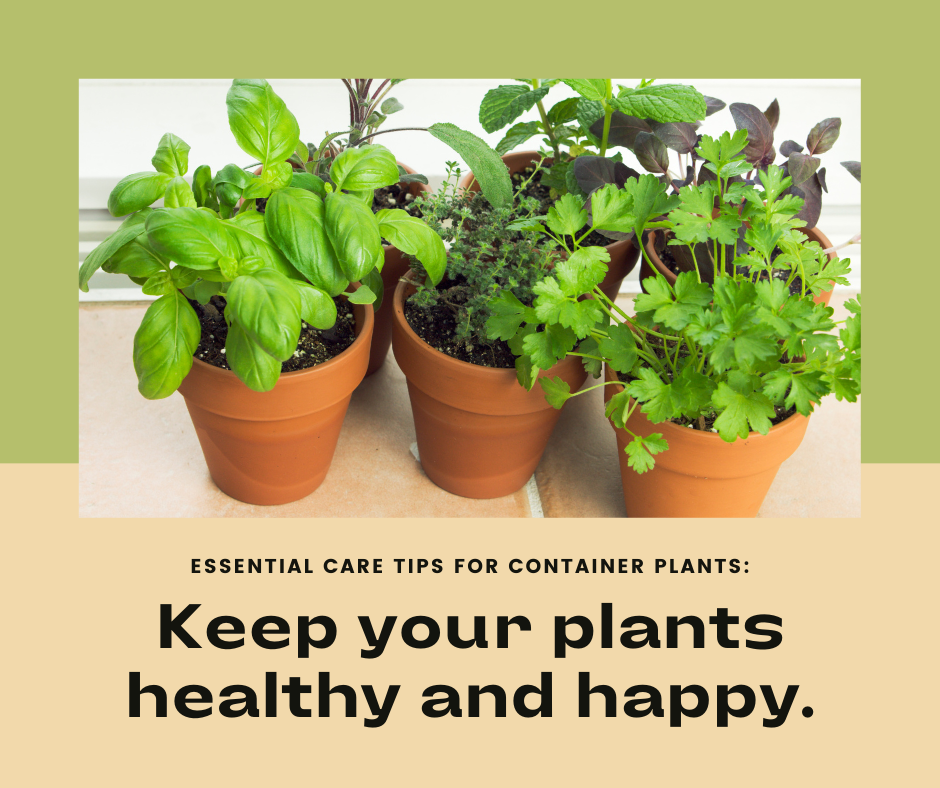
Proper care is essential for ensuring the health and vitality of your container plants. By following these essential care tips, you can create a thriving container garden that will flourish throughout the seasons.
Watering and Feeding Your Container Plants
Watering is a critical aspect of container gardening. It’s important to strike a balance between under-watering and over-watering your plants. The frequency of watering will depend on various factors such as plant type, size of the container, and weather conditions. As a general rule, check the soil moisture regularly and water when the top inch feels dry. Avoid waterlogging by providing adequate drainage or using self-watering containers.
Feeding your container plants is another crucial step in their care routine. Since the nutrients in the potting mix eventually get depleted, it’s important to replenish them with a balanced fertilizer. Look for a slow-release or liquid fertilizer formulated specifically for container plants. Follow the recommended dosage instructions and feed your plants at regular intervals throughout the growing season.
Managing Pests and Diseases in Container Gardening
Container gardening is not without its share of pests and diseases. Common pests like aphids, spider mites, and snails can wreak havoc on your plants if left unmanaged. Regularly inspect your plants for signs of infestation, such as yellowing leaves or chewed leaves, and take prompt action.
Pro Tip: If you notice pests on your container plants, try using organic pest control methods such as neem oil or insecticidal soap. These options are effective in controlling pests while minimizing harm to beneficial insects.
Preventing diseases in container gardening starts with good sanitation practices. Avoid overwatering, which can lead to waterlogged soil and promote the growth of disease-causing fungi. Additionally, remove any diseased foliage or plants from your container garden to prevent the spread of diseases.
Essential Care Tips for Thriving Container Plants
| Aspect | Tips |
|---|---|
| Watering | – Check soil moisture regularly – Water when the top inch is dry – Provide adequate drainage or use self-watering containers |
| Feeding | – Use a balanced fertilizer – Choose slow-release or liquid form – Follow recommended dosage and feeding schedule |
| Pest Management | – Regularly inspect plants for pests – Use organic pest control methods if necessary |
| Disease Prevention | – Practice good sanitation – Avoid overwatering – Remove diseased foliage or plants |
By implementing these essential care tips, you can ensure that your container plants receive the attention they need to thrive. With proper watering, feeding, and pest and disease management, your container garden will flourish and bring you joy throughout the year.
Showcasing Your Container Garden Like a Pro
Now that you have created a beautiful container garden, it’s time to showcase it like a pro. Whether you have a small balcony or a spacious backyard, these tips and ideas will help you make your container garden a stunning focal point in your outdoor space.
Create a Striking Arrangement
Arranging your containers in an eye-catching way can instantly elevate the visual appeal of your container garden. Consider grouping containers of varying heights and sizes together for a dynamic effect. Play with different textures and colors to create a harmonious arrangement that grabs attention.
“The overall design of your container garden should capture your personal style while also complementing your outdoor space.” – Emily Green, Container Gardening Expert
Add Focal Points
Introduce focal points in your container garden to draw the eye and create visual interest. This can be achieved by incorporating taller plants, such as ornamental grasses or flowering vines, in strategic locations. Place these focal point plants in the center or at the back of your containers to create depth and drama.
Use Color and Texture to Your Advantage
Color coordination and texture variation are key elements in showcasing your container garden. Choose plant combinations that have contrasting colors and textures to create a vibrant and visually appealing display. For example, pair delicate ferns with bold, flowering plants to create a striking contrast.
Accessorize with Decorative Features
Add decorative features to enhance the overall look of your container garden. Consider incorporating elements such as decorative stones, colorful pebbles, or even small garden ornaments. These accessories can add a touch of personality and whimsy to your garden.
Highlight with Lighting
Don’t let the beauty of your container garden go unnoticed after the sun sets. Illuminate your containers with strategic lighting to create an enchanting ambiance in your outdoor space. Use solar-powered lights or LED strip lights to highlight your containers and plants, making them stand out even at night.
By following these tips and ideas, you can showcase your container garden like a pro and create a visually stunning outdoor space that will impress your friends and neighbors.
Common Mistakes to Avoid in Container Gardening
Container gardening is a fantastic way to bring the beauty of plants into smaller spaces or create stunning focal points in your outdoor area. However, novice gardeners often encounter common pitfalls that can hinder the success of their container gardens. By being aware of these mistakes and taking preventive measures, you can ensure that your container garden thrives and flourishes. In this section, we’ll highlight the most common mistakes to avoid in container gardening and provide practical guidance on how to overcome them.
1. Neglecting Proper Drainage
One of the most frequent mistakes in container gardening is overlooking the importance of proper drainage. Without adequate drainage, excess water can collect in the soil, leading to root rot and the eventual demise of your plants. To avoid this issue, ensure that your containers have drainage holes at the bottom and use well-draining soil mixtures. It’s also essential to place saucers or trays beneath the pots to catch any excess water and prevent waterlogging.
2. Overwatering or Underwatering
Watering is a critical aspect of container gardening, but getting it right can be challenging. Overwatering can drown the plants, leading to root rot, while underwatering can cause them to wither and die. It’s crucial to strike a balance by understanding the water needs of your specific plants and monitoring soil moisture levels. Factors such as climate, plant size, and container material can affect watering frequency. Remember to check the top inch of soil regularly and water only when it feels dry to the touch.
3. Choosing the Wrong Container Size
The size of the container plays a significant role in the overall health and growth of your plants. Choosing containers that are too small can restrict root growth and limit the plant’s ability to absorb nutrients and water. On the other hand, oversized containers can lead to waterlogged soil and decreased oxygen availability for the roots. Research the mature size of your plants and select containers that provide enough space for their roots to spread and develop properly.
4. Ignoring Light Requirements
Every plant has specific light requirements, and ignoring these needs can result in weak growth or even plant death. Before selecting plants for your container garden, assess the lighting conditions in the chosen location. Some plants thrive in full sun, while others prefer partial shade or full shade. Matching the plant’s light requirements with the available light is crucial for their overall health and vitality.
5. Using the Wrong Soil
The soil you use in your containers can make a significant difference in the well-being of your plants. Using garden soil or low-quality potting soil can lead to poor drainage and nutrient deficiencies. It’s best to invest in high-quality potting mixtures specifically designed for container gardening. These mixtures are lightweight, well-draining, and enriched with nutrients that support plant growth.
6. Neglecting Fertilization
Container plants rely on the nutrients provided by the soil and fertilizers. Neglecting fertilization can lead to nutrient deficiencies, resulting in stunted growth and poor flowering. Regularly fertilize your container plants with a balanced, slow-release fertilizer or use organic alternatives to ensure they receive the necessary nutrients for healthy growth. Follow the manufacturer’s instructions for application rates and schedule.
7. Not Considering the Plant’s Growth Habit
Understanding the growth habit of your chosen plants is essential for successful container gardening. Some plants, such as vining or sprawling varieties, require ample space to spread and thrive. Overcrowding your containers can lead to competition for resources and limited growth. Research the mature size and growth habits of your plants and choose compatible varieties that won’t hinder each other’s growth.
8. Neglecting Disease and Pest Control
Avoiding disease and pest issues is crucial for maintaining the health of your container garden. Regularly inspect your plants for signs of pests, such as aphids, mealybugs, or spider mites. If detected, take immediate action to prevent infestations from spreading to other plants. Additionally, practice good hygiene by removing dead or diseased plant material promptly. This will help minimize the risk of diseases and foster a healthy growing environment.
Taking steps to avoid these common mistakes will set you on the path to container gardening success. By providing proper drainage, considering light requirements, choosing the right container size, using quality soil, fertilizing appropriately, and staying vigilant against pests and diseases, you’ll create an environment where your container plants can thrive and bring joy for years to come.
| Mistake | Consequence | Preventive Measure |
|---|---|---|
| Neglecting Proper Drainage | Root rot and plant death due to waterlogged soil | Ensure containers have drainage holes and use well-draining soil mixtures |
| Overwatering or Underwatering | Root rot or plant withering due to improper watering | Monitor soil moisture and water only when the top inch feels dry |
| Choosing the Wrong Container Size | Restricted root growth or waterlogged soil | Research plant’s mature size and select appropriate container size |
| Ignoring Light Requirements | Weak growth or plant death due to insufficient light | Match plant’s light requirements with available light in the garden |
| Using the Wrong Soil | Poor drainage and nutrient deficiencies in plants | Invest in high-quality potting mixtures specifically designed for container gardening |
| Neglecting Fertilization | Nutrient deficiencies leading to stunted growth | Regularly fertilize with a balanced, slow-release fertilizer or organic alternatives |
| Not Considering the Plant’s Growth Habit | Competition for resources and limited growth | Choose compatible plant varieties that won’t hinder each other’s growth |
| Neglecting Disease and Pest Control | Diseases and pest infestations damaging plants | Regularly inspect plants, take preventive measures, and practice good hygiene |
FAQ
Q. What are the benefits of container gardening?
A. Container gardening offers several benefits, especially for those with limited space or looking for easy maintenance options. It allows you to grow plants in small areas like balconies or patios, and it requires less time and effort for tasks such as weeding and soil preparation.
Q. What factors should I consider when choosing containers for my garden?
A. When choosing containers for your garden, consider factors such as size, material, drainage, and aesthetics. Make sure the container is appropriate for the size of the plant and allows excess water to drain effectively. Additionally, choose materials that are durable and suitable for the outdoor environment.
Q. What types of containers are suitable for different plants?
A. There are various types of containers suitable for different plants. Traditional pots are versatile and can accommodate a wide range of plants. Hanging baskets are ideal for trailing plants, while vertical gardens provide a space-saving solution. Choose the type of container based on the specific needs and growth habits of your plants.
Q. How can I select the perfect plants for my containers?
A. Selecting the perfect plants for your containers involves considering factors such as growth habit, light requirements, and climate considerations. Choose plants that are suitable for the available space and the amount of sunlight your container garden receives. Also, consider the climate in your region to ensure the plants will thrive.
Q. How can I design my container garden for visual interest?
A. Designing a container garden for visual interest involves principles such as color coordination, texture variation, and height variation. Choose plants with complementary colors and contrasting leaf textures. Create visual interest by arranging plants of varying heights, from tall specimens to trailing vines.
Q. What are some essential care tips for thriving container plants?
A. To ensure your container plants thrive, it’s important to water and feed them appropriately. Water your plants when the top inch of soil feels dry, and use a well-balanced fertilizer to provide necessary nutrients. Additionally, regularly inspect your plants for pests and diseases and take preventive measures to keep your container garden healthy.
Q. How can I showcase my container garden like a pro?
A. To showcase your container garden like a pro, pay attention to arrangement and focal points. Arrange your containers in visually appealing groupings, using different heights and textures. Create focal points with statement plants or strategically placed decorations. Experiment with different arrangements to find what works best for your space.
Q. What are some common mistakes to avoid in container gardening?
A. Some common mistakes to avoid in container gardening include over or under-watering, using improper soil or containers, and neglecting pest and disease management. It’s important to provide proper care, including regular watering and using well-draining soil. Choose containers that provide adequate space for root growth, and regularly inspect your plants for signs of pests or diseases.
Conclusion
Container gardening offers a versatile and convenient way to bring greenery into your life, even if space is limited. Throughout this article, we have explored the essential principles of container gardening and provided valuable insights into creating a thriving container garden.
By choosing the right containers for your plants and considering factors like size, material, and drainage, you can create an optimal environment for your plants to flourish. Understanding the types of containers suitable for different plants will ensure you make the right choices, while selecting the perfect plants based on growth habit, light requirements, and climate considerations will set you up for success.
To truly make your container garden stand out, designing it with visual interest in mind is key. Incorporate color coordination, texture variation, and height variation to create a harmonious and eye-catching display. And don’t forget about proper care – watering and feeding your container plants, as well as managing pests and diseases, are essential for their well-being.
In conclusion, container gardening is a rewarding and accessible way to enjoy the beauty of plants. By applying the principles discussed in this article, you can create your own thriving container garden, regardless of your space limitations. So go ahead, get your hands dirty, and unleash your creativity to transform any small area into a vibrant oasis of greenery.


